| Home | Material | My Telescopes | Mirror Making | Deep Sky | ext. Links |
| Deutsch (de)![]()
| Home | Material | My Telescopes | Mirror Making | Deep Sky | ext. Links |
32" f/4.5 Mirror
This was a joint project with Ralph Muth and Frank Richardsen, two experienced deep sky observers, who want to build something lightweight and compact, that collects one star magnitude more light than their current 20" scopes. "What, you want to BUY the mirror?"- this hit my glass pusher heart. "WE can make it!" Our configuration seems to be ideal: Frank wants Einstein's Cross brightly shining with all its 4 components, Ralph wants to try, if 32 inch will fit into his Opel Corsa and I can satisfy my mania for large thin mirror making. So the blank rolled end of December 2001 into my room and is dominating it by its pure size.
| Grinding | Arrival of the
pregenerated Pyrex blank: This shall collect over 13,000 times as much light as the unaided eye! |
| The working stand: A 30 mm
(1.2") thick sheet set on 80 x 80 mm (3.1 x3.1") feet. It is
stable enough to handle even the large forces at
polishing.
|
|
| The tool made of hard plaster
and tiles: Diameter: 480 mm (18") Thickness incl. tiles : 70 mm (2 3/4") Weight: 21 kg (46 lb) The unglazed tiles 50 x 50 mm (1" x 1") were glued with epoxy resin onto the tool. Note the cutouts in the plaster that serve as grips for a safer handling of the heavy tool. |
|
| Make the tool match with grit #120 (#180 would have done as well) and grinding out the successive grits with TOP (Tool on Top). The mirror remains on the stand and is being rotated from time to time. When changing the grit size the mirror is washed at it's place. Anyhow; I can't carry the 130 pounds of glass safely into the bathroom. After finishing the grit everything is cleaned thoroughly, the carpet is vacuumed and all sponges are thrown away. | |
| Prior to every wet the glass/carbo paste is wiped off with a sponge, while the tool remains on the mirror and is just pushed to the side. This prevents such accidents like glass chipping, squeezed fingers or broken backs, that could happen when lifting and dropping the 46 pounds tool all the time. | |
| Frank invented as a glass pusher
newbie the TOT&T method: "Tool on Top with Tie". The
principle is genius: You look after the tie not to become wet and
concentrate less on the grinding process. Thus, the strokes you make are
erratic, which prevents systematical errors and zones. The result is a
spherical mirror, ha!
After a total of 28 hours the mirror was ground out and ready for polishing.
|
|
| Polishing | |
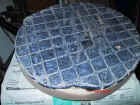 |
The 40 cm (16") 13 kg (29
lb) plaster tool with 28° pitch. The room temperature is 20°C. The
relatively hard pitch digs less into the edge and lowers the risk of a
TDE. For parabolizing I will switch to the softer 23° pitch, to get a
better fit to the aspherical surface.
While I cut the cannels with a saw, there are existing more elegant ways. |
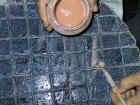 |
The ceroxyd (CEO) is mixed into water and is brushed over the pitch lap. Orange CEO at 1.6 m particle size cuts much faster than red rouge or the white polishing compound I used years ago. At the final parabolizing stages I will use 0.7 m particle size. |
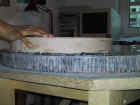 |
In order to prevent astigmatism due to bending, large thin mirrors should be ground flat at the backside and should rest on a flat and stable underground. Between mirror and underground I use a piece of carpet, to compensate the remaining unevenness. |
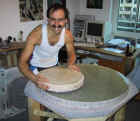 |
A 16" pitch lap seems quite small to act
on a 32" mirror, but this is the maximum size I can push around for
some time. The windows fog, the heart beat rises to 125 / min and the
sweat pores open widely. So put on your running dress and keep the pitch
in motion. It's essential to change the stroke length and to concentrate on the edge with the right amount of overhang, since this is polishing out at last. Don't forget to vary the direction of the strokes (back and forth, left - right, diagonal) and to walk continuously around the stand and to turn the mirror from time to time, to prevent polishing asymmetries into the glass! |
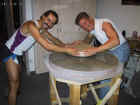 |
It's easier and much more fun, to work in a team.... |
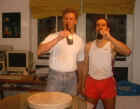 |
...and to prevent deydration |
|
Judging the polishing progress with an eyepiece as magnifier and a
flashlight. The
pits scatter the light and glow like "stars" in the backlight. I have
set up a scale to follow the progress of the polishing process: 0. Fine dull crater surface. End of fine grinding 1. Reflex of a light bulb visible. Surface itself still dull 2. First shiny bridges between the pits 3. Pits look like a globular cluster 4. Dense milky way 5. Average star field 6. Thinner star field 7. Sparse star field 8. Rare pits 9. Here and there pits to be found 10. Polished out. From now on please approach the surface with a tie only and talk to it as "Sir" I personally don't like the laser pointer method as much, since a completely polished mirror shows still a weak reflex which makes it difficult to judge, when the mirror is really polished out. |
|
| After 13 polishing hours the center is at stage 7 and the edge at stage 6. | |
|
After 22 hrs. polished out, but 20-30 scratches. Where do they come from? Some
things in the universe, we will obviously not understand.
---> Continue, to polish at least some of them out. |
|
| After 22 + additional 15 hrs. 13 fine scratches are still there. That's enough cosmetic, since they have no influence at all. The mirror must relax now a bit ... ok, it's more my body that needs to regenerate for a while. | |
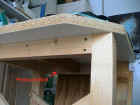
|
The flexing Working Stand: No matter what strokes I made, there remained a central hill on the mirror. I am sure this is due to the flexing of the central part of the mirror and table. Therefore I added an reinforcing bar under the middle of the stand an applied a central bolt that presses against the table (see picture at left). I hope to be able, to control with this bold the flex of the table and thus the flex of the mirror. |
Additional issues and activities that I have to face during parabolizing:
I appreciate any comments or ideas to this topic.
At the end: Who said, it is easy to make a 32 inch?
Update 2016:
After many years of no activity, Winni and Andy took the mirror and finished the project.
https://www.astrotreff.de/forum/index.php?thread/196165-das-ende-der-leiter
https://www.outer-rim.eu/projekte/tschuri.html
It was presented at the telecope meeting on Almberg / Bavaria:
https://www.astrotreff.de/forum/index.php?thread/200911-der-berg-ruft-almbergtreffen-2016/&pageNo=3
To top of this page
Home | Imprint | Privacy Policy | About |